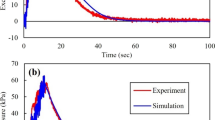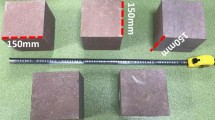Abstract
The 2010–2011 Canterbury earthquake sequence in New Zealand exposed loess-mantled slopes in the area to very high levels of seismic excitation (locally measured as >2 g). Few loess slopes showed permanent local downslope deformation, and most of these showed only limited accumulated displacement. A series of innovative dynamic back-pressured shear box tests were undertaken on intact and remoulded loess samples collected from one of the recently active slopes replicating field conditions under different simplified horizontal seismic excitations. During each test, the strength reduction and excess pore water pressures generated were measured as the sample failed. Test results suggest that although dynamic liquefaction could have occurred, a key factor was likely to have been that the loess was largely unsaturated at the times of the large earthquake events. The failure of intact loess samples in the tests was complex and variable due to the highly variable geotechnical characteristics of the material. Some loess samples failed rapidly as a result of dynamic liquefaction as seismic excitation generated an increase in pore water pressure, triggering rapid loss of strength and, thus, of shear resistance. Following initial failure, pore pressure dissipated with continued seismic excitation and the sample consolidated, resulting in partial shear strength recovery. Once excess pore water pressures had dissipated, deformation continued in a critical effective stress state with no further change in volume. Remoulded and weaker samples, however, did not liquefy and instead immediately reduced in volume with an accompanying slower and more sustained increase in pore pressure as the sample consolidated. Thereafter, excess pressures dissipated and deformation continued at a critical state. The complex behaviour explained why, despite exceptionally strong ground shaking, there was only limited displacement and lack of run-out: dynamic liquefaction was unlikely to occur in the freely draining slopes. Dynamic liquefaction, however, remained a plausible mechanism to explain loess failure in some of the low-angle toe slopes, where a permanent water table was present in the loess.


















Similar content being viewed by others
References
Bannister SC, Gledhill KR (2012) Evolution of the 2010–2012 Canterbury earthquake sequence. N Z J Geol Geophys 55(3):295–304
Bell DH, Glassey PJ, Yetton MD (1986) Chemical stabilisation of dispersive loessical soils, Banks Peninsula, Canterbury, New Zealand. Proceed 5th Int Congress Int Eng Geol Soc 1:2193–2208
Bell DH, Trangmar BB (1987) Regolith materials and erosion processes on the Port Hills, Christchurch, New Zealand. Proceedings of the Fifth International Conference and Field Workshop on Landslides, Christchurch, pp 93–105
Brain MJ, Rosser NJ, Sutton J, Snelling K, Tunstall N, Petley DN (2015) The effects of normal and shear stress wave phasing on coseismic landslide displacement. J Geophysical Res Earth Surface 120:1009–1022
Brown LJ, Weeber JH (1992) Geology of the Christchurch urban area. Scale 1:25,000. Institute of Geological & Nuclear Sciences geological map, 1
BSI (British Standards Institute) (1981) Code of practice for site investigations. BS 5930: 1981
BSI (British Standards Institute) (1990) British standard methods of test for soils for civil engineering purposes. Part 1: general requirements and sample preparation. BS 1377: part 1
Carey JM, Misra S, Bruce Z, Barker P (2014) Canterbury Earthquakes 2010/2011 Port Hills slope stability: laboratory testing factual report. GNS Science Consultancy Report 2014/53
Castro G, Enos JL, France JW, Poulos SJ (1982) Liquefaction induced by cyclic loading. National Science Foundation NSF/CEE-82018
Cruden DM, Varnes DJ (1996) Landslide types and processes. In: Turner AK, Schuster RL (eds) Landslides: investigation and mitigation. Special Report 247. Transportation Research Board, US National Research Council, Washington, DC, pp 36–75
Dellow G, Yetto M, Massey CI, Archibald GC, Barrell DJA, Bell D, Bruce Z, Campbell A, Davies T, De Pascale G, Easton M, Forsyth PJ, Gibbons C, Glassey PJ, Grant H, Green R, Hancox GT, Jongens R, Kingsbury P, Kupec J, Macafarlane D, McDowell B, McKelvey B, McCahon M, McPherson I, Molloy J, Muirson J, O’Hallaran M, Perrin ND, Price C, Read SAL, Traylen N, Van Dissen RJ, Villeneuve M, Walsh I (2011) Landslides caused by the 22 February 2011 Christchurch earthquake and management of landslide risk in the immediate aftermath. Bull N Z Soc Earthq Eng 44(4):227–238
Della Pasqua F, Massey C I, Lukovic B, Ries W, Archibald G, Heron D (2014) Canterbury Earthquakes 2010/11 Port Hills slope stability: risk assessment for Maffeys Road. GNS Science Consultancy Report 2014/79
Evans SG, Roberts NJ, Ischuk A, Delaney KB, Morozova GS, Tutubalina O (2009) Landslides triggered by the 1949 Khait earthquake, Tajikistan, and associated loss of life. Eng Geol 109(3–4):195–212
Fletcher L, Hungr O, Evans SG (2002) Contrasting failure behaviour of two large landslides in clay and silt. Can Geotech J 39(1):46–62
Glassey PJ (1986) Geotechnical properties of lime stabilised loess, Port Hills, Canterbury. Unpublished MSc thesis, University of Canterbury
Gledhill K, Ristau J, Reyners M, Fry B, Holden C (2011) The Darfield (Canterbury, New Zealand) Mw 7.1 earthquake of September 2010: a preliminary seismological report. Seismol Res Lett 82(3):378–386
Griffiths E (1973) Loess of Banks Peninsula. N Z J Geol Geophys 16:657–675
Kaiser A, Holden C, Beavan J, Beetham D, Benites R, Celentano A, Collett D, Cousins J, Cubrinovski M, Dellow G, Denys P, Fielding E, Fry B, Gerstenberger M, Langridge R, Massey C, Motagh M, Pondard N, McVerry G, Ristau J, Stirling M, Thomas J, Uma SR, Zhao J (2012) The Mw 6.2 Christchurch earthquake of February 2011: preliminary report. N Z J Geol Geophys 55(1):67–90
Massey CI, Yetton MJ, Carey JM, Lukovic B, Litchfield N, Ries W, McVerry G (2013) Canterbury Earthquakes 2010/11 Port Hills slope stability: stage 1 report on the findings from investigations into areas of significant ground damage (assessed source areas). GNS Science Consultancy Report, 2012/317
Massey CI, Della Pasqua F, Lukovic B, Ries W, Heron D (2014a) Canterbury Earthquakes 2010/11 Port Hills slope stability: risk assessment for Cliff Street. GNS Science Consultancy Report, 2014/73
Massey C, McSaveney M, Taig T, Richards L, Litchfield N, Rhoades D, McVerry G, Lukovic B, Heron D, Ries W, Van Dissen R (2014b) Determining rockfall risk in Christchurch using rockfalls triggered by the 2010/2011 Canterbury earthquake sequence, New Zealand. Earthquake Spectra 30:155–181
McDowell BJ (1989) Site investigations for residential development on the Port Hills, Christchurch. MSc thesis (unpublished), University of Canterbury
McRoberts EC, Sladen JA (1992) Observations on static and cyclic sand liquefaction methodologies. Can Geotech J 29:605–665
Raeside JD (1964) Loess deposits of the South Island, New Zealand, and soils formed on them. N Z J Geol Geophys 7:811–838
Ristau J, Holden C, Kaiser AE, Williams CA, Bannister SC, Fry B (2013) The Pegasus Bay aftershock sequence of the M w 7.1 Darfield (Canterbury), New Zealand earthquake. Geophys J Int 195(1):444–459
Goldwater S (1990) Slope failure in loess. A detailed investigation, Allendale, Banks Peninsula. MSc thesis (unpublished), University of Canterbury
Sasitharan S, Robertson PK, Sego DC, Morgenstern NR (1993) Collapse behaviour of sand. Can Geotech J 30:569–577
Seed HB (1966) Landslides during earthquakes due to soil liquefaction. J Soil Mech Found Div ASCE 94(5):1055–1122
Sladen JA, D’Hollender RD, Krahn J (1985) The liquefaction of sands, a collapse surface approach. Can Geotech J 22(4):564–578
Tehrani BH (1988) Chemical stabilistaion of Whaka Terrace loess. Unpublished MSc thesis, University of Canterbury
Ter-Stepanian G (1998) Suspension force induced landslides. In: Proceedings of the 8th International Congress, International Association of Engineering Geology and the Environment, Vancouver, vol 3, pp 1905–1912
Varnes DJ (1978) Slope movement types and processes. In: Schuster RL, Krizek RJ (eds) Landslide analysis and control. National Academy of Sciences, Transportation Research Board Special Report 176, pp 11–33
Wang G, Sassa K (2002) Post-failure mobility of saturated sands in undrained load controlled ring shear tests. Can Geotech J 39:821–837
Wang G, Sassa K, Fukuoka H, Tada T (2007) Experimental study on the shearing behavior of saturated silty soils based on ring shear tests. J Geotech Geoenviron Eng ASCE 133(3):319–333
Wang G, Zhang D, Furuya G, Yang J (2014) Pore-pressure generation and fluidization in a loess landslide triggered by the 1920 Haiyuan earthquake, China: a case study. Eng Geol 174:36–45
Xu L, Dai F, Tu X, Tham GT, Zhou Y, Iqbal J (2014) Landslides in a loess platform, North-west China. Landslides 11(6):993–1005
Yetton MD (1986) Investigation and remedial methods for subsurface erosion control in Banks Peninsula loess. MSc thesis (unpublished), University of Canterbury
Wen B, Wang S, Wang E, Zhang J (2004) Characteristics of rapid giant landslides in China. Landslides 1:247–261
Zhang D, Sassa K (1996) Study of the mechanism of loess landslides induced by earthquakes. J Jpn Soc Erosion Control Eng 49:4–13 (in Japanese)
Zhang D, Wang G (2007) Study of the 1920 Haiyuan earthquake-induced landslides in loess (China). Eng Geol 94:76–88
Zhang D, Takeuchi A, Sassa K (1995) The motion characteristics of loess landslides induced by the Haiyuan earthquake in Ningxia Province, China. J Jpn Landslide Soc 32(1):12–17 (in Japanese)
Zhang FY, Wang G, Kamai T, Chen WW, Zhang DX, Yang J (2013) Undrained shear behaviour of loess saturated with different concentrations of sodium chloride solution. Eng Geol 155:69–79
Zou JS, Shao SM (1996) Landslides induced by Haiyuan earthquake and their distribution. Cont Earthquake 10:1–5 (in Chinese)
Acknowledgments
The authors thank Chris Massey and Mark Yetton for information and advice. Christchurch City Council facilitated site access and provided data from boreholes and mapping studies. Zane Bruce and Mark Yetton assisted in the field sampling. Stuart Read and Peter Barker are thanked for their support during the laboratory testing and analysis phase which was undertaken within the GNS Rock and Soil Mechanics Laboratory. We also thank our GNS Science colleagues Will Ries and Darren D’Cruz who prepared the figures and Phil Glassey for his constructive review of an earlier draft of this manuscript. The research has in part been supported by the GNS Science Strategic Development Fund, the GNS Direct Crown Funded Landslide Hazards Programme and by the NERC/ESRC Increasing Resilience to Natural Hazards Programme under the Earthquakes Without Frontiers project, grant reference NE/J01995X/1 and NERC/Newton Fund grant NE/N000315.
Author information
Authors and Affiliations
Corresponding author
Rights and permissions
About this article
Cite this article
Carey, J.M., McSaveney, M.J. & Petley, D.N. Dynamic liquefaction of shear zones in intact loess during simulated earthquake loading. Landslides 14, 789–804 (2017). https://doi.org/10.1007/s10346-016-0746-y
Received:
Accepted:
Published:
Issue Date:
DOI: https://doi.org/10.1007/s10346-016-0746-y




